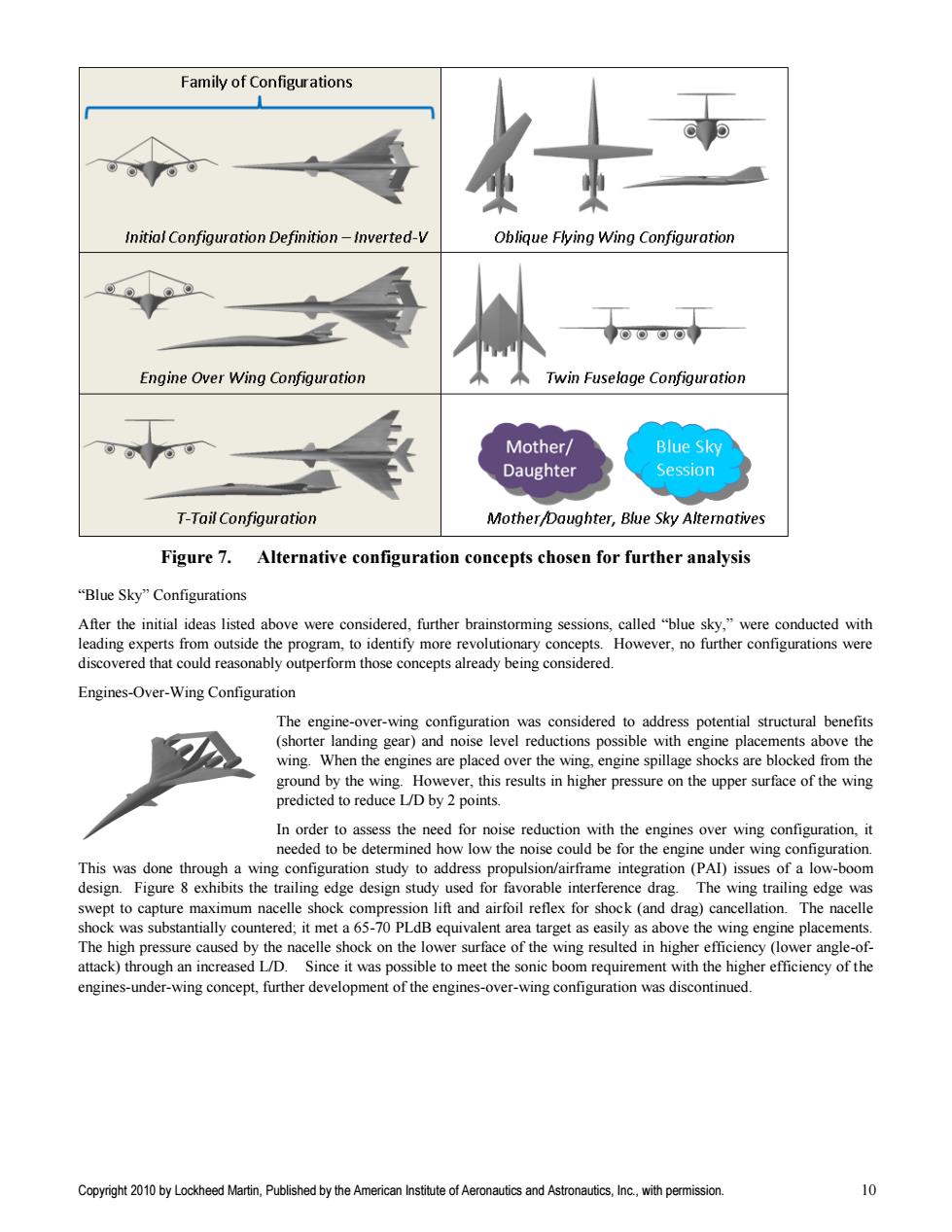正在加载图片...

Family of Configurations Initial Configuration Definition-Inverted-V Oblique Flying Wing Configuration Engine Over Wing Configuration Twin Fuselage Configuration Mother/ Blue Sky Daughter Session T-Tail Configuration Mother/Daughter,Blue Sky Alternatives Figure 7.Alternative configuration concepts chosen for further analysis "Blue Sky"Configurations After the initial ideas listed above were considered,further brainstorming sessions,called "blue sky,"were conducted with leading experts from outside the program,to identify more revolutionary concepts.However,no further configurations were discovered that could reasonably outperform those concepts already being considered. Engines-Over-Wing Configuration The engine-over-wing configuration was considered to address potential structural benefits (shorter landing gear)and noise level reductions possible with engine placements above the wing.When the engines are placed over the wing,engine spillage shocks are blocked from the ground by the wing.However,this results in higher pressure on the upper surface of the wing predicted to reduce L/D by 2 points. In order to assess the need for noise reduction with the engines over wing configuration,it needed to be determined how low the noise could be for the engine under wing configuration. This was done through a wing configuration study to address propulsion/airframe integration (PAI)issues of a low-boom design.Figure 8 exhibits the trailing edge design study used for favorable interference drag.The wing trailing edge was swept to capture maximum nacelle shock compression lift and airfoil reflex for shock (and drag)cancellation.The nacelle shock was substantially countered;it met a 65-70 PLdB equivalent area target as easily as above the wing engine placements. The high pressure caused by the nacelle shock on the lower surface of the wing resulted in higher efficiency (lower angle-of- attack)through an increased L/D.Since it was possible to meet the sonic boom requirement with the higher efficiency of the engines-under-wing concept,further development of the engines-over-wing configuration was discontinued. Copyright 2010 by Lockheed Martin,Published by the American Institute of Aeronautics and Astronautics,Inc.,with permission. 10Copyright 2010 by Lockheed Martin, Published by the American Institute of Aeronautics and Astronautics, Inc., with permission. 10 Figure 7. Alternative configuration concepts chosen for further analysis ―Blue Sky‖ Configurations After the initial ideas listed above were considered, further brainstorming sessions, called ―blue sky,‖ were conducted with leading experts from outside the program, to identify more revolutionary concepts. However, no further configurations were discovered that could reasonably outperform those concepts already being considered. Engines-Over-Wing Configuration The engine-over-wing configuration was considered to address potential structural benefits (shorter landing gear) and noise level reductions possible with engine placements above the wing. When the engines are placed over the wing, engine spillage shocks are blocked from the ground by the wing. However, this results in higher pressure on the upper surface of the wing predicted to reduce L/D by 2 points. In order to assess the need for noise reduction with the engines over wing configuration, it needed to be determined how low the noise could be for the engine under wing configuration. This was done through a wing configuration study to address propulsion/airframe integration (PAI) issues of a low-boom design. Figure 8 exhibits the trailing edge design study used for favorable interference drag. The wing trailing edge was swept to capture maximum nacelle shock compression lift and airfoil reflex for shock (and drag) cancellation. The nacelle shock was substantially countered; it met a 65-70 PLdB equivalent area target as easily as above the wing engine placements. The high pressure caused by the nacelle shock on the lower surface of the wing resulted in higher efficiency (lower angle-ofattack) through an increased L/D. Since it was possible to meet the sonic boom requirement with the higher efficiency of the engines-under-wing concept, further development of the engines-over-wing configuration was discontinued